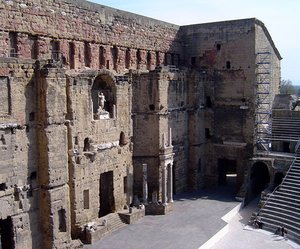Orange, France
|
|
Orange (Arenjo in Provençal) is a city in the département of Vaucluse, in the south of France. It has a population of about 26,000 people, with a primarily agricultural economy. It is located at 44°08N 4°48E, about 21 km north of Avignon. The town is renowned for its Roman architecture; it possesses the best preserved Roman theatre in Europe, as well as a particularly fine triumphal arch, both built during the reign of Augustus. The arch, theatre and surroundings were listed in 1981 by UNESCO as a World Heritage Site.
History
Roman Orange was founded in 35 BC by veterans of the Second Gallica Roman legion as Arausio (after the local Celtic water god), or Colonia Julia Firma Secundanorum Arausio in full, "the Julian colony of Arausio established by the soldiers of the second legion".
It covered an area of some 170 acres (690,000 m²) and was well endowed with civic monuments—as well as the theatre and arch, it had a monumental temple complex and a forum. It was the capital of a wide area of northern Provence, which was parcelled up into lots for the Roman colonists.
The town prospered, though it was sacked by the Visigoths in 412. It became a bishopric in the 4th century, and the hill fort of the Celtic Cavares was renamed for Saint Eutrope, the first bishop of Saintes. Christian Orange hosted two synods, in 441 and 529. The latter was of importance in condemning the Pelagian heresy. The sovereign Carolingian counts of Orange had their origin in the 8th century, and passed into the family of the lords of Baux.
The Baux counts of Orange became fully independent with the breakup of the Kingdom of Arles after 1033. From the 12th century, Orange was raised to a minor principality, as a fief of the Holy Roman Empire. When William I "the Silent", count of Nassau, with estates in the Netherlands, inherited the title Prince of Orange in 1544, the Principality was incorporated into the holdings of what became the House of Orange. This pitched it into the Protestant side in the Wars of Religion, during which the town was badly damaged. In 1568 the Eighty Years War began with William as stadtholder leading the bid for independence from Spain. William the Silent was assassinated in Delft in 1584. It was his son, Maurice of Nassau (Prince of Orange after his elder brother died in 1618), with the help of Johan van Oldenbarnevelt, who solidified the independence of the Dutch republic. The United Provinces survived to become the Netherlands, which is still ruled by the House of Orange-Nassau. William, Prince of Orange, ruled England as William III of England. Orange gave its name to other Dutch-influenced parts of the world, such as the Orange Free State in South Africa.
The city was part of scattered Nassau holdings until it was captured by the forces of Louis XIV in 1672 during the war against Holland and was ceded to France in 1713 under the Treaty of Utrecht. Following the French Revolution of 1789, it was absorbed into the French département of Drôme, then Bouches-du-Rhône, then finally Vaucluse. However, the title remained with the Dutch Princes of Orange.
In 1869 the Roman theatre was restored and has played host ever since to a famous music festival, the Chorégies (named after the tax that was imposed on wealthy Romans to pay for theatrical productions).
Orange attracted international attention for a quite different reason in the 1990s, when it elected a member of the extreme right-wing Front National as its mayor. It is still run by the FN, which regards it as its flagship.fr:Orange (Vaucluse) it:Orange (Francia) ja:オランジュ nl:Orange (Frankrijk) no:Orange, Frankrike pl:Orange (miasto we Francji) ro:Orange, Franţa sv:Orange (stad) de:Orange (Frankreich)

